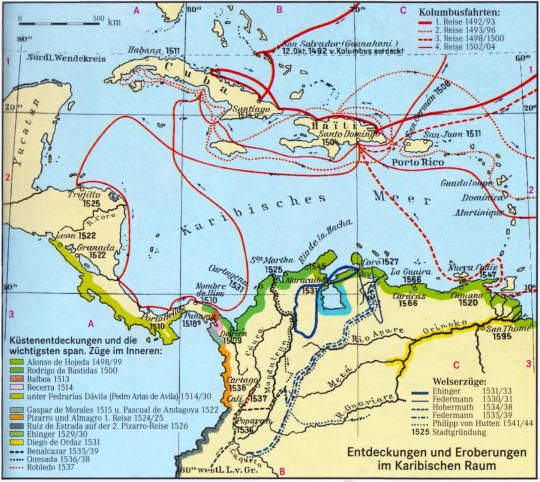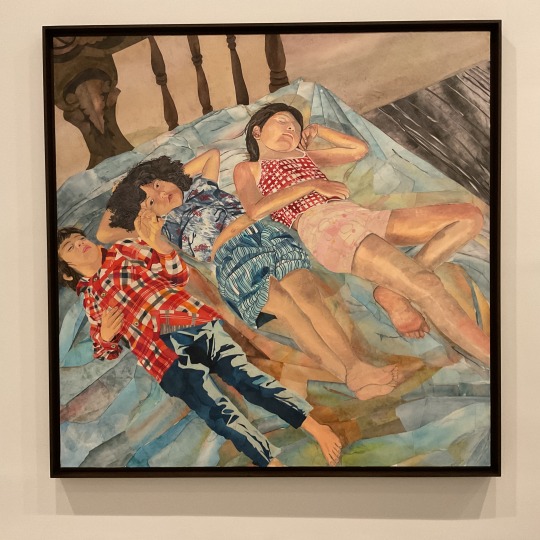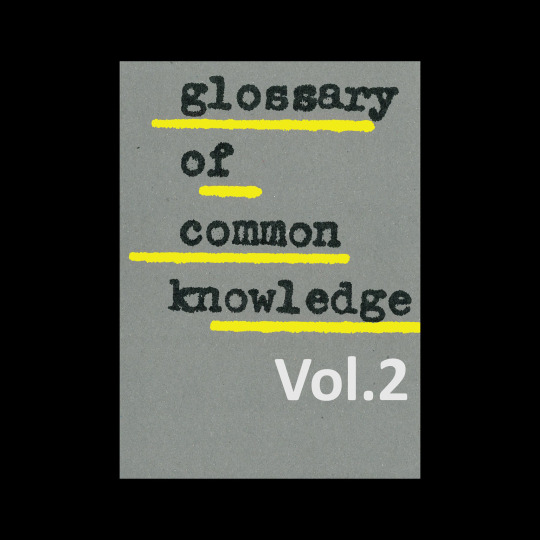#maría berrío
Explore tagged Tumblr posts
Text

María Berrío (Colombian, active in USA, 1982), La Cena [Dinner], 2012. Wax crayon, graphite, fabric collage and Japanese rice paper collage on canvas, 48 x 58 in.
175 notes
·
View notes
Photo

María Berrío (Colombian, b. 1982), A Sunburst Restrained, 2019. Collage and watercolor on paper, 60 x 72 in.
393 notes
·
View notes
Text

María Berrío
3 notes
·
View notes
Text

María Berrío — Anemochory, collage with Japanese paper and watercolor paint on canvas (2019)
6 notes
·
View notes
Text
al things considered — when i post my masterpiece #1161

first posted in facebook march 1, 2023
maría berrío -- "the oracle's silence" (2019)
"my work is grounded in storytelling. i create these imaginary tales that have to do with, say, human migration, feminism, or ecological disasters, and present them from a surrealistic point of view" ... maría berrío
"the oracle was written on a silver leaf last night i read the words did you read them too?" ... patti smith
"you got 'the gift,' but it looks like you're waiting for something" ... oracle
"people posting songs ... that choices never shared ... no one dared ... disturb ... the sands ... of silence" ... al janik
#maría berrío#the oracle's silence#storytelling#imaginary tales#patti smith#the oracle was written#oracle#the matrix#the gift#the sands of silence#al things considered
0 notes
Photo

Discovery and conquest of the Caribbean Sea by the Spanish, 1492-1595.
« Westermann Großer Atlas zur Weltgeschichte », 1997
by cartesdhistoire
On October 12, 1492, Christopher Columbus reached San Salvador in what is now the Bahamas archipelago, then he discovered the northeast coast of Cuba and Haiti (La Española). During a second expedition, he discovered Dominica and Guadeloupe, then he explored the south coast of Cuba and discovered Jamaica (Santiago). His brother Bartolomé founded Santo Domingo in 1498. In 1508, Ponce de León named a harbor on the island Puerto Rico, which took its name, then he founded San Juan in 1511.
During his third voyage, in 1498, Columbus reached the island of Trinidad and discovered the mouths of the Orinoco River: the flow of the river indicated that the hinterland was much larger than the islands previously discovered. So, the idea of “mainland” began to emerge. In 1499, Alonso de Ojeda, accompanied by Amerigo Vespucci, explored the coast from east to west, starting from Guyana. On the shores of Lake Maracaibo, upon seeing Indians living in huts on stilts, he named this region “Venezuela”, meaning little Venice.
Rodrigo de Bastidas discovered the mouth of the Magdalena River and was the first to land on the Isthmus of Panama in 1500. During his fourth voyage, Columbus sailed along the coast of the isthmus from present-day Honduras (1502). Vasco Nuñez de Balboa founded Santa María la Antigua del Darién in 1510, the first permanent colony on the mainland, then he discovered the “South Sea” in 1513. Pedrarias Dávila founded Panama in 1519.
In 1528, Charles V granted the exploitation of Venezuela to Augsburg bankers, the Welsers. The expedition of Nicolás de Federmán reached the land of the Muiscas in the Andes in 1539.
The first European to ascend the Orinoco was Diego de Ordaz in 1531 (he was also the first European to reach the summit of the Popocatépetl volcano in Mexico). Where the Orinoco narrows the most, Antonio de Berrío founded the town of Santo Tomás de Guayana in 1595.
In the Andes, Benalcázar founded the Spanish Quito in 1534, then Popayán in 1537, and Jiménez de Quesada founded Santa Fe de Bogotá in 1538.
96 notes
·
View notes
Text




This year, we were thrilled to see María Berrío’s work at the ICA Boston. Berrío (born 1982) crafts her large-scale collage paintings through a unique, meticulous process of collaging torn pieces of Japanese paper with watercolor to create riveting, magical scenes. Some of the images in this post are from her exhibit at the ICA Boston.
Born in Bogotá, Columbia, María Berrío is a visual artist working in Brooklyn, New York. She grew up between a house in Bogotá and a farm in the Colombian countryside. Berrío came to the United States at the age eighteen to attend Parsons School of Design for her BFA, later completing her MFA at the School of Visual Arts in Manhattan in 2007.
Berrío’s large-scale works reflect on cross-cultural connections and global migration, often highlighting women and children. She draws inspiration from her childhood memories and South American cultural roots and landscapes.
“Much of Berrío’s work centers on the themes of women’s resilience, immigration, and climate awareness. Elegantly intertwining these three concepts throughout her art, Berrío delves into the complexities of womanhood by showing the struggles, triumphs, and challenges that women face both in private spaces and in nature. Women and children are her primary subjects, and her own personal relationships with the environment and the landscape help shape her artistic approach.” (p.109, “María Berrío: Constructing a Community of Courageous Women through Collage”)
Image 1: Ozymandias, 2022 at ICA Boston
Image 2: Under Thatch and Autumn Star, 2022 at ICA Boston
Image 3: The Conference of the Sparrows, 2023 at ICA Boston
Image 4: María Berrío in her Brooklyn studio, NY (from “We are here: visionaries of color transforming the art world”)
María Berrío: Constructing a Community of Courageous Women through Collage Cushman, Emily COLLEGE PK: Feminist Studies, Inc Feminist studies, 2022, Vol.48 (1), p.108-132
We are here : visionaries of color transforming the art world Hernandez, Jasmin [(author, interviewer)] New York: Abrams, 2021. English 2021 HOLLIS number: 99155702467103941
#HispanicHeritageMonth#LatinxAndHispanicHeritageMonth#ColombianAmericanArtist#WomenArtist#MariaBerrio#HarvardFineArtsLibrary#Fineartslibrary#Harvard#HarvardLibrary#ICABoston
21 notes
·
View notes
Photo

GLOSSARY OF COMMON KNOWLEDGE, Vol. 2 Care is conflictual Contribution
Curated by Zdenka Badovinac, Ida Hiršenfelder, Bojana Piškur and Jesús Carrillo. Published by Moderna galerija, Ljubljana, 2022.
The terms by more than fifty narrators presented in this volume were discussed and written between 2019 and 2022 during seminar meetings to bring together diverse knowledges from the museums as well as the so-called global family of artists, thinkers and curators. They seek to find common knowledge to speak about less visible stories in contemporary art and to address systems that govern our ways of thinking in art and beyond. The project has been ongoing since 2014, and it was conceived and curated by Zdenka Badovinac, Bojana Piškur and Jesús Carrillo in the context of L’Internationale confederation of museums as a method of addressing the so-called referential fields. The first series of discussions was published in 2018. For this second edition, we repeated the same referential fields to re-examine how the conditions in our cultural landscape have changed in the drastic raptures of pandemic, war, climate catastrophes, a conservative turn and political upheavals. One of the most visible shifts in this volume compared to the previous edition is a clear need to address the growing urgency of climate change, and to stress the anthropogenic colonial origin of the cataclysmic events, moreover, to entangle this continuous crisis through troubled thinking, and propose not to resign. This volume is also marked by the COVID-19 pandemic and the implications it had on escalating power struggles and injustices. Contributors of terms: Zdenka Badovinac, María Berríos, Miha Blažič (N’toko), Sara Buraya Boned, Jesús Carrillo, Sebastian Cichocki, Fatma Çolakoğlu, Nicolás Cuello, Jakub Depczyński, Kike España, Pauliina Feodoroff, Maddalena Fragnito, Elisa Fuenzalida, Nancy Garín Guzmán, Deniz Gül, Jennifer Hayashida, Ida Hiršenfelder, Alistair Hudson, Maria Iñigo Clavo, Goran Injac, Vladan Joler, Yuji Kawasima, Gal Kirn, Ram Krishna Ranjan, Vali Mahlouji, Sophie Mak-Schram, Javiera Manzi A., Diego Marchante “Genderhacker”, Pablo Martínez, Miran Mohar, Meriç Öner, Bojana Piškur, Theo Prodromidis, Tjaša Pureber, Rasha Salti, Anja Isabel Schneider, Natalia Sielewicz, Antoine Silvestre, Maja Smrekar, Jonas Staal, Bogna Stefańska, Kuba Szreder, Steven ten Thije, Abhijan Toto, Fran MM Cabeza de Vaca, Chương-Đài Võ, Mick Wilson, Onur Yıldız, Joanna Zielińska, Yolande Zola Zoli van der Heide Curated by Zdenka Badovinac, Ida Hiršenfelder, Bojana Piškur and Jesús Carrillo. Published by Moderna galerija, Ljubljana, 2022. To purchase the full publication, please contact the bookstore in the Museum of Modern Art, Ljubljana, or the bookstore Museum of Contemporary Art Metelkova, Ljubljana.

Chapters
Table of contents
On Making the Glossary by Ida Hiršenfelder
2022ISBN 978-961-206-153-1
2 notes
·
View notes
Text

María Berrío (Colombian, 1982), The Crossing, 2023. Collage with Japanese papers and watercolor paint on linen, 80 x 130 in.
60 notes
·
View notes
Photo

María Berrío (Colombian, b. 1982), A Cloud’s Roots, 2018. Collage and watercolor on paper, 80 x 96 in.
60 notes
·
View notes
Text

María Berrío
2 notes
·
View notes









